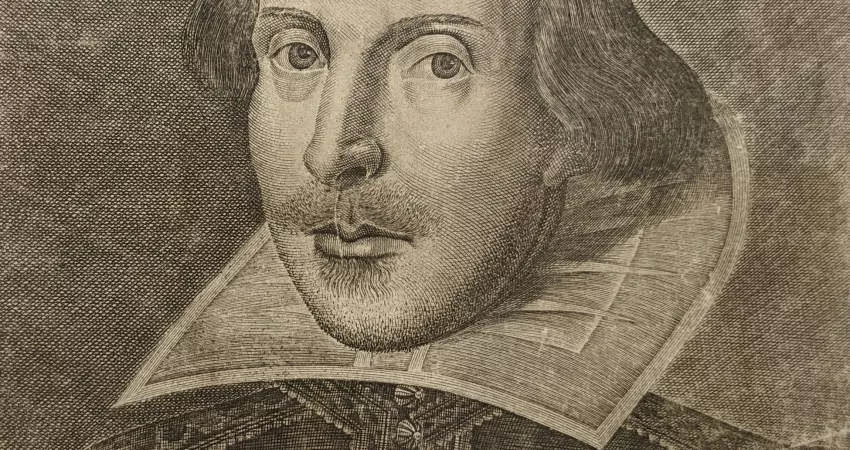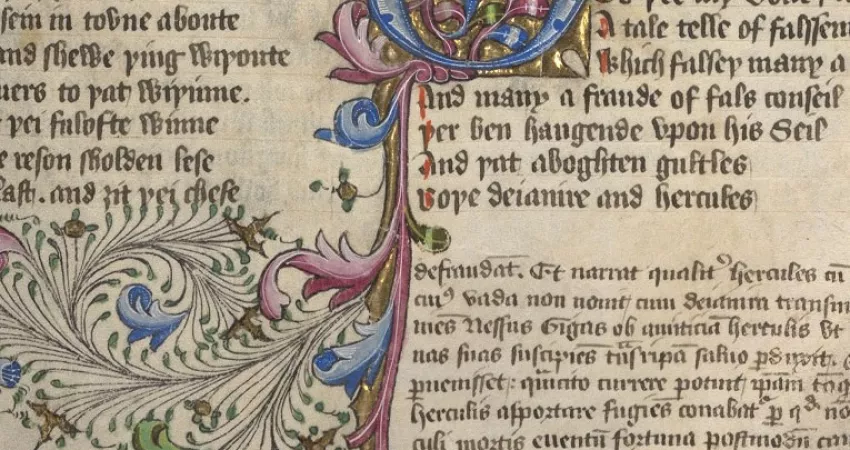We are beginning our literary journey through the English language in the Middle Ages.
This period was a time of tension—one in which ideas about England and the English language changed dramatically in the centuries after the country’s defeat in 1066 and the subsequent Norman conquest. It is in these centuries that an English recognisable to modern speakers started to be formed and one in which literature helped to shape the beginnings of an English national consciousness.
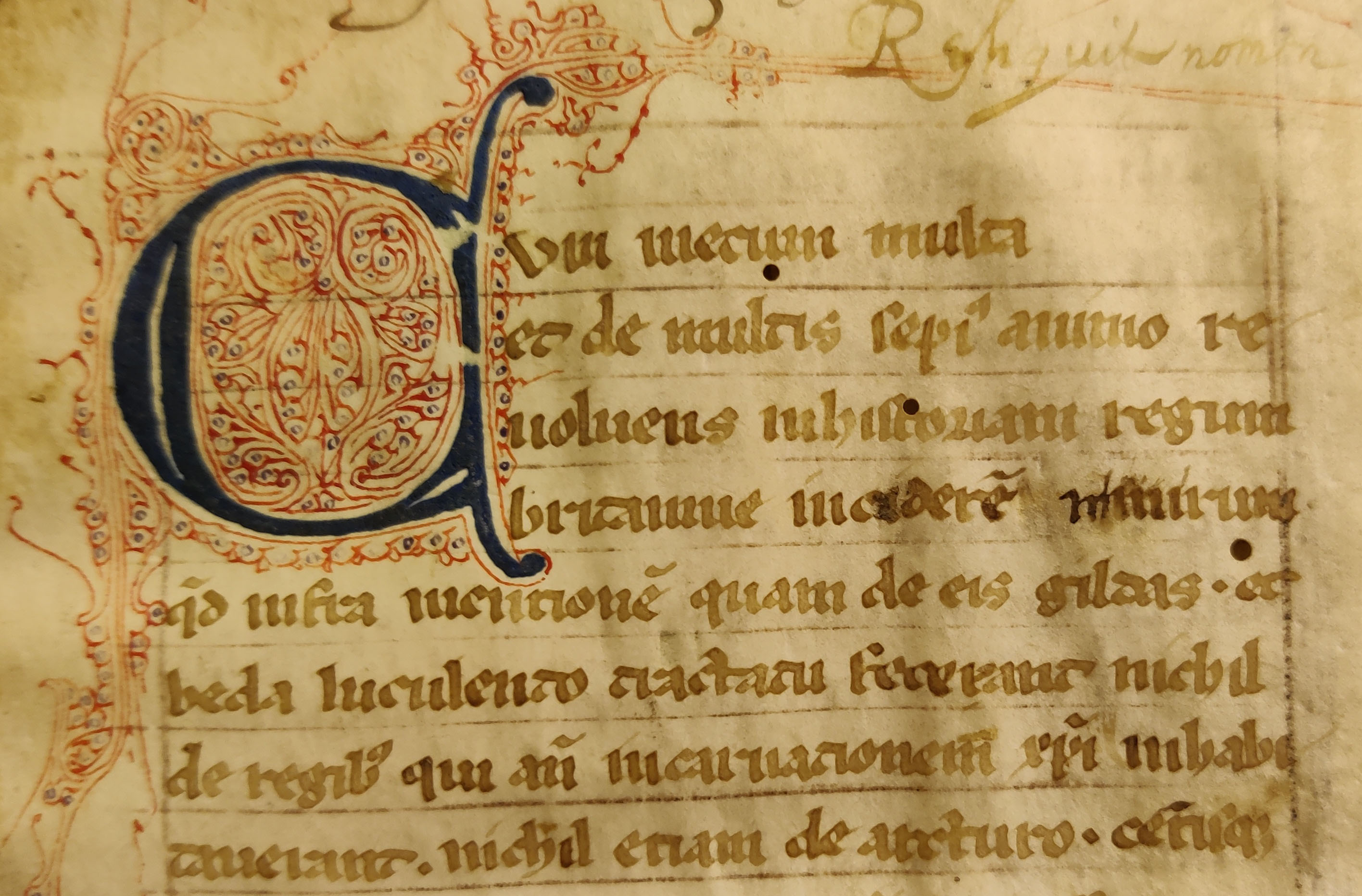
Both the start of this process and its continuing development can be seen in the collections of New College Library. The manuscript you can see above is the first folio of MS 276, which dates from the 13th century. A copy of Geoffrey of Monmouth’s History of the Kings of Britain, it is emblematic of one of the greatest bodies of medieval literature associated with Great Britain—the story of King Arthur.
One of the great story cycles of the Western Middle Ages, which endures in reworkings and retellings up to this day, Geoffrey of Monmouth’s text was fundamental in the creation of an Arthurian legend. The text draws heavily on a number of early histories and early Welsh texts, bardic oral tradition, genealogical tracts, and—last but not least—Geoffrey’s own imagination.
Geoffrey’s text was influential throughout Western Europe, especially in the French chivalric romances of Chrétien de Troyes (d. 1180–90) and then their Middle High German translations (c. 1185–1210). Interestingly, though, it quickly started to become important to English writers and a developing English sense of nationhood. Although this New College copy is written in the original Latin, The History of the Kings of Britain was translated into an early form of Middle English surprisingly quickly—in 1215 in the West Midlands. This early English manuscript also expanded and improvised upon the original material, crucially replacing a reference to the ‘British’ (Brüttes) with the English (‘Anglen’). Indeed, this interest in King Arthur was central to a revival of English poetry in the 14th century, before reaching a high point in the 15th century, when Thomas Malory (c. 1400–1470) composed an English narrative of Morte d’Arthur.
New College’s MS 276, therefore, represents the beginnings of a literature not only focused on Britain, but one that subsequently came to be used in English literary texts. Below, you can see the manuscript open at the beginning of book 9, which tells of the death of Uther Pendragon, and Arthur's accession to the throne of Britain—see if you can find Uther Pendragon’s name in the text and then click on the hotspot to reveal the answer.
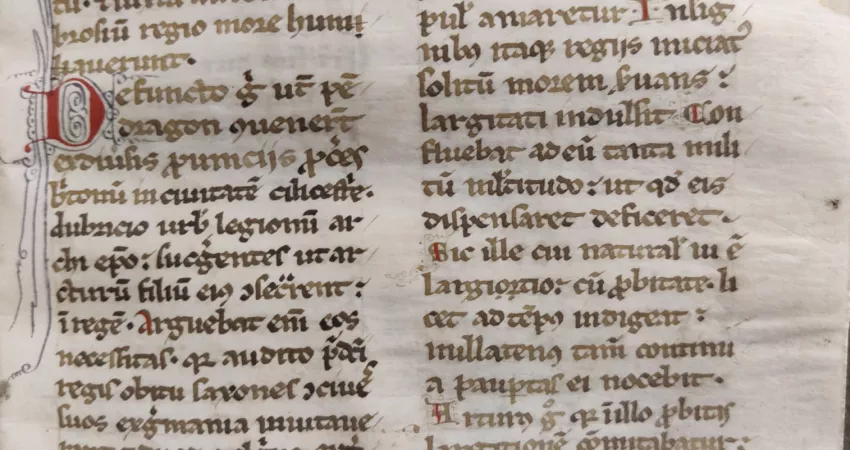
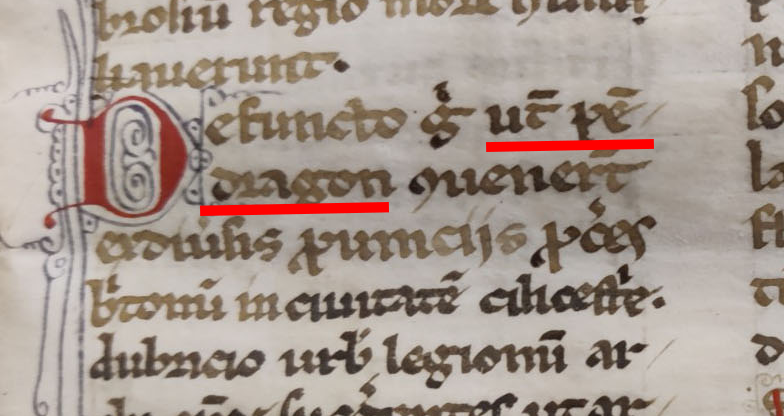
Uther Pendragon’s name is in the left-hand column (highlighted in the image above).
New College Library, Oxford, MS 276, f. 98r
In subsequent centuries, the use of the English language in literary texts became even more established.
Well-known writers—such as Geoffrey Chaucer and John Gower—not only translated existing texts into English, but also produced new work in the vernacular in the fourteenth century. As with Geoffrey of Monmouth, the collections at New College Library contain important manuscripts from this period. One such manuscript is MS 314, a copy of Chaucer’s Canterbury Tales—easily the preeminent work of Middle English literature. Although sadly now incomplete, the colophon of this fifteenth century manuscript, apparently written by the scribe, reveals that at one point it contained all the tales in Chaucer’s collection:
![New College Library, Oxford, MS 314, f. 311v [detail]](/sites/default/files/inline-images/MS%20314%20colophon.jpg)
In Latin, it reads ‘Explicit Tractatus Galfridi Chauser de Gestis peregrinorum versus Cantuariam’ [Here ends the treatise of Geoffrey Chaucer on the acts of the Canterbury Pilgrims].
This manuscript is fascinating and particularly important on account of its scribe having inserted additional obscene words and verses of his own into the text to emphasise female sexuality, spurred on by Chaucer’s own existing obscenities in his work. The longest addition, an additional eight lines of verse to the scene of Damyan and May’s copulation in a pear-tree in ‘The Merchant’s Tale’, can be seen below:
![New College Library, Oxford, MS 315, f. 95v [detail]](/sites/default/files/inline-images/MS%20314%2C%20Folio%2095v.jpg)
The first three lines read:
She saide it was the meriest fit
That ever in her lif she was at yet.
MS 314 demonstrates an increasing confidence in the use of English as a literary language throughout the fourteenth and fifteenth centuries. Written in a plain, cursive hand, with some red and blue decoration, the additions added by the scribe demonstrate how texts were starting to be commented on and altered in the vernacular. Its unique nature still draws attention even today, as it has become an important research tool for Chaucerian scholars the world over.
New College’s medieval literary manuscripts extend beyond Chaucer.
In fact, the Library is also home to two medieval manuscripts of another key work in medieval English literature—the Confessio Amantis or ‘Lover’s Confession’ (c. 1390) by John Gower (d. 1408). This fact is even more remarkable when you consider that only 49 manuscripts of his work have survived globally. In this 33,000-line poem, written mostly in Middle English, the ageing, despairing lover Amans makes confession to the chaplain of Venus, who prompts him to admit in detail the ways in which he is guilty of committing, in his love-affairs, the deadly sins of Pride, Envy, Wrath, Sloth, Gluttony, and Avarice. Each of these forms the topic of one of the poem’s eight books, and is illustrated through a number of short narrative exempla.
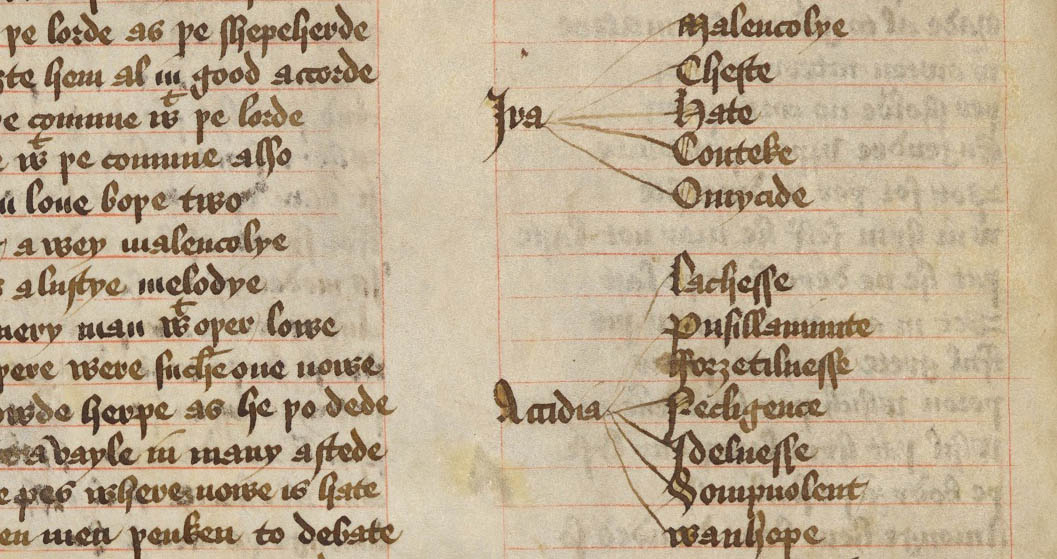
The later of our two manuscripts, MS 326, dates from between 1450 and 1475. Above, you can see folio 7 verso, which depicts the end of the prologue. If you look at the right-hand side of the page, you can see that the scribe has added a list of cardinal sins—here you can see Ira [wrath] and Acedia [sloth]. Each sin is then divided into various sub-sins, which functions as a table of contents for the first four books of the poem.
Our earlier manuscript, MS 266, dates from the first quarter of the 15th century and is highly unusual, because it is one of only two which contain (or once contained) full cycles of illustrations: miniatures illustrating the short narratives. The manuscript is partially mutilated; some miniatures have been robbed, such that only nineteen of the original thirty-three survive. Discover more about this treasure of New College Library in the video below, presented by our former Special Collections Curatorial Assistant, Dr Antje Frotscher:
Together, these three manuscripts highlight an increasing confidence in the use of English as a literary language throughout the medieval period.
At the start of this period, texts relating to England were often produced in Latin or French. Throughout the fourteenth century, though, texts started to be produced directly in the vernacular—as New College’s Chaucer and Gower manuscripts reveal. As the texts in these manuscripts were further altered by scribes, they provide unique research tools for researchers.
Later, texts would be changed further, with the Renaissance bringing about profound changes in the type of texts produced. As technology developed, such as the printing press, there was also an explosion in the type and number of texts available. Read on to discover more.
